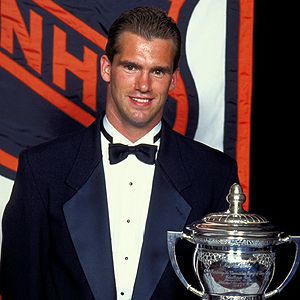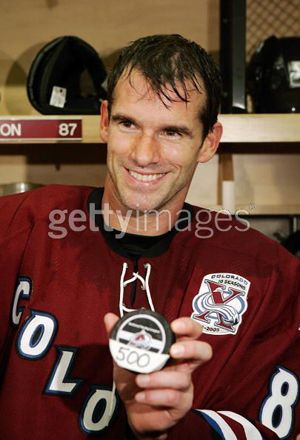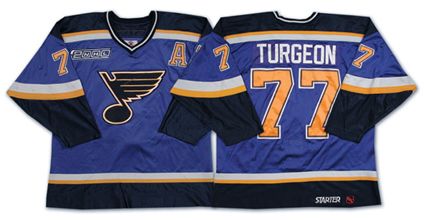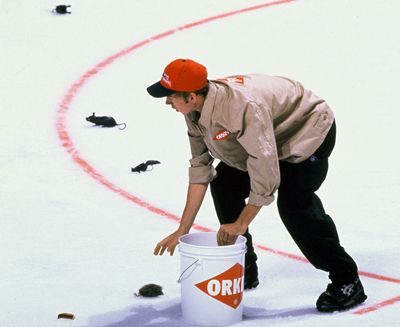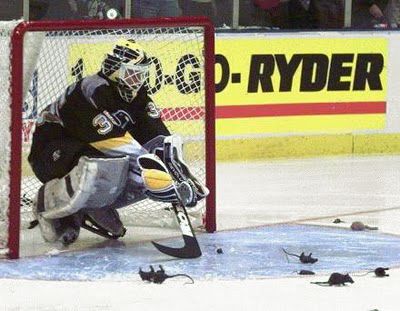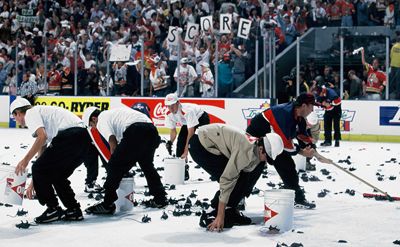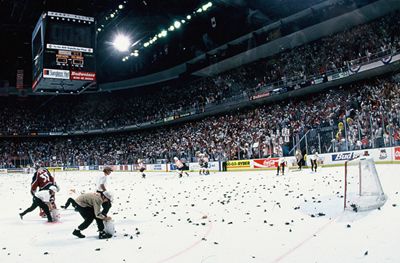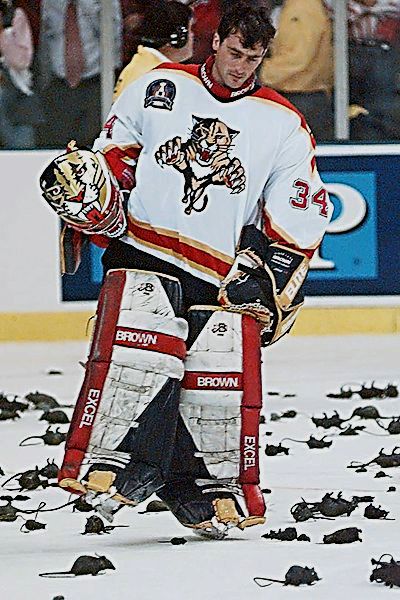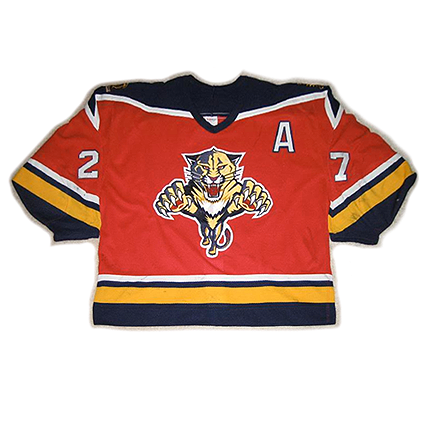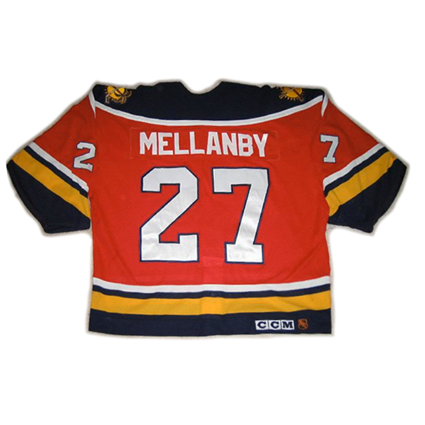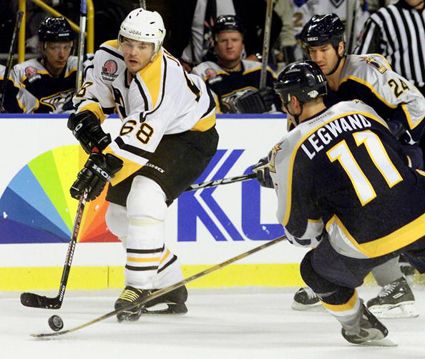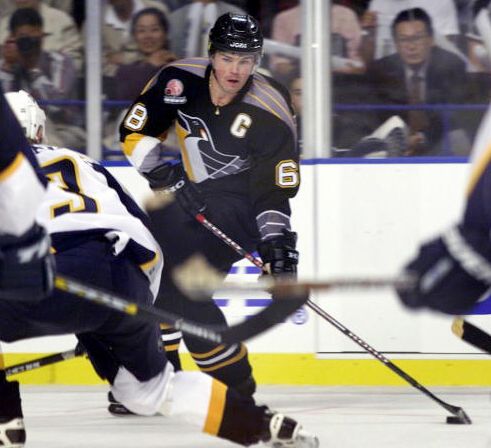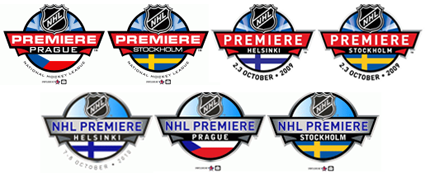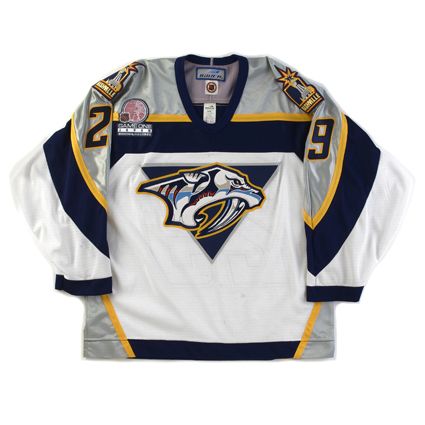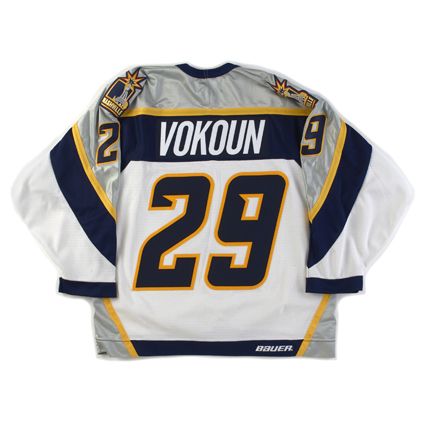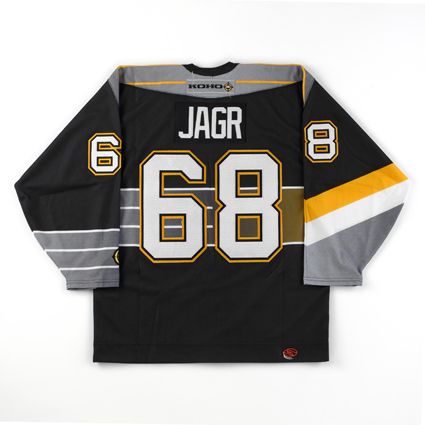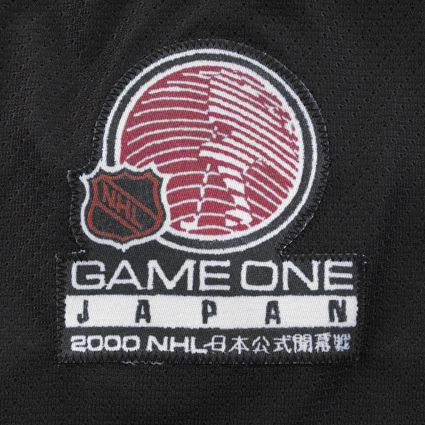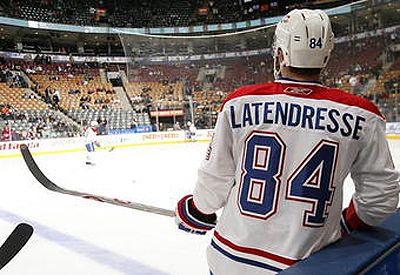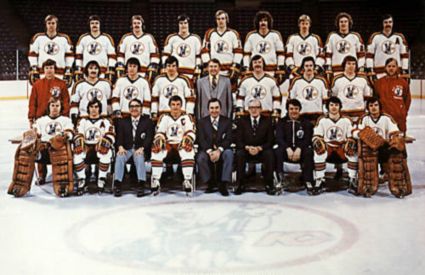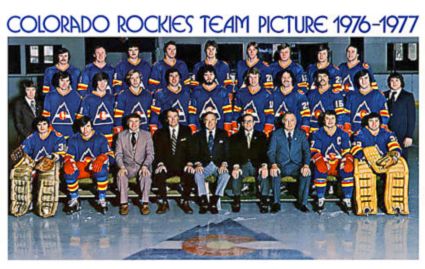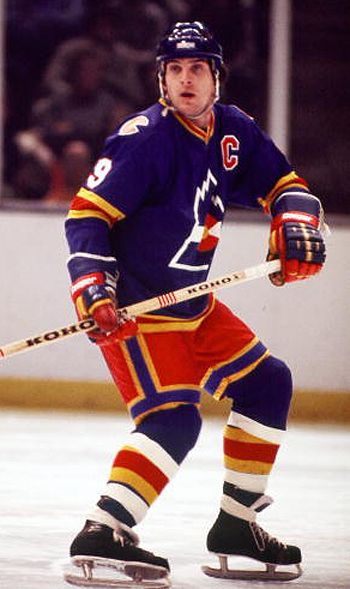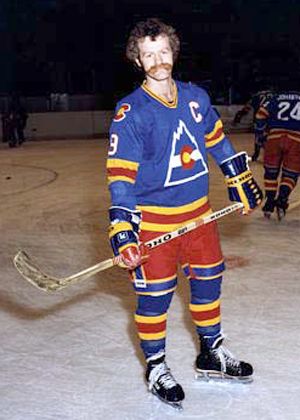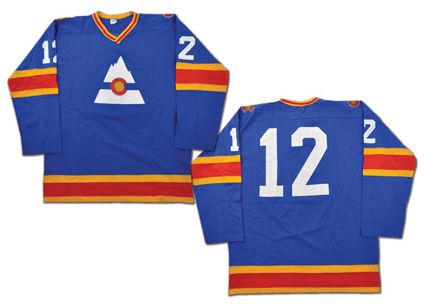Saturday, October 9, 2010
1999-2000 St. Louis Blues Pierre Turgeon Jersey
Pierre Turgeon was drafted 1st overall in the 1987 NHL Entry Draft by the Buffalo Sabres and begain his NHL career in 1987-88 with a serviceable 42 points in 76 games. He more than doubled that total in just his second season with his first 30 goal season when he scored 34 goals and 54 assists for 88 points. He cemented his place as a fan favorite and team leader the next season with his first 100 point season, when he hit the 40 goal plateau and tallied 106 points. Once again he reached 30 goals in 1990-91 with 32, although his overall scoring dipped to 79 points.
In the first of some notable trades, Turgeon was dealt to the New York Islands along with Benoit Houge, Uwe Krupp and Dave McLlwain for Pat LaFontaine, Randy Wood and Randy Hiller plus future considerations.
He was a fan favorite on Long Island and would lead the Islanders in scoring, by margins of 7, 45 and 19 points, during his three full seasons with the club and finish tied for second the year he was traded away, despite playing in only 34 games, such was the state of the lowly Islanders in 1994-95.
His best season with the Islanders was the 1992-93 season when he would net 58 goals and add 74 assists for a 132 points, placing 5th overall in the league in what would prove to be his highest scoring season as a pro. He was also awarded the Lady Byng Trophy after the conclusion of the season.
Turgeon accepts the Lady Byng Trophy
When Islanders General Manager Don Maloney traded Turgeon to the Montreal Canadiens in 1994-95, concerned that Turgeon would never be the same player after the Dale Hunter incident, it turned into a nightmare for the Islanders, as Canadiens captain Kirk Muller was the main player the Islanders received in return for Turgeon, and Muller was clearly at a point in his career where he wanted to compete for another Stanley Cup, and not lead the downtrodden Islanders back to respectability. In the end, Muller would play just 27 games for the Islanders while Turgeon was named captain of the Canadiens for the final season at the historic Montreal Forum in which he scored 38 goals and 96 points.
After only nine games of the 1996-97 season, Turgeon was once again on the move, this time to St. Louis to join the Blues in a five player deal that brought Shayne Corson to Montreal. There, Turgeon found a level of stability, playing five seasons with St. Louis, where he averaged more than a point per game (1.09) with a high of 82 in 2000-01. His time in St. Louis included scoring his 1,000th point on this date in 1999 with a power play goal in a 4-2 win over the Edmonton Oilers.
After five seasons in St. Louis, Turgeon signed on with the Dallas Stars as a free agent for the 2001-02 season. His offensive numbers reflected his changed role while with the Stars as he did not surpass 50 points again in his career, something that had only occurred once before in his career when he had 47 points in 49 games during the strike shortened season of 1994-95 while splitting time between the Islanders and Canadiens.
Following three years with Dallas, he signed as a free agent with the Colorado Avalanche coming out of the NHL lockout of 2004-05. While with Colorado that first season, Turgeon reached the 500 goal mark, just the 34th player in NHL history to reach that elusive milestone. He was limited to just 17 games by various injuries in his final season of 2006-07 and retired from the NHL in September of 2007.
Turgeon displays his 500th goal puck
His career point totals were 515 goals and 812 assists for 1,327 points in 1,294 games, a 1.03 point per game average for his entire 19 year NHL career.
Today's featured jersey is a 1999-2000 St. Louis Blues Pierre Turgeon jersey as worn during the season Turgeon scored his 1,000th NHL point as a member of the Blues.
The Blues changed to this style jersey full time after introducing a white version of this style as an alternate in 1997. They promoted that very well received jersey to the primary home jersey the following season and created today's blue road version to round out the set which replaced the controversial previous set which had repeating diagonal stripes and road jerseys with an unprecedented amount of red.
Turgeon is a fun player to collect, as his instantly recognizable #77 has been worn on the classic Sabres jersey with the Sabres 20th Anniversary patch and later the NHL 75th Anniversary patch, the classic New York Islanders jersey with both the NHL 75th Anniversary patch and the Islanders 20th Anniversary patch in 1991-92 and the Stanley Cup Centennial patch in 1992-93.
He then wore the iconic jerseys of the Montreal Canadiens while wearing both the assistant's "A" and captain's "C", the Blues jerseys with the repeating diagonal stripes and the subsequent set featured today with the NHL 2000 patch, both Blues styles with the assistant captain's "A", the wonderful Dallas Stars set with the integrated star shape in the body, the bizarre Stars "Mooterus" alternate, the championship era Colorado Avalanche jerseys (while wearing the unfamiliar #87), including their diagonally crested burgundy alternate, with the Avalanche 10th Anniversary patch and the one game only Teammates for Kids patch.
Additionally, Turgeon also played in four NHL All-Star Games in 1990, 1993, 1994 and 1996, giving the collector 16 different jerseys with multiple patching options to pursue.
Today's video section begins with the drafting of Turgeon #1 overall by the Buffalo Sabres.
Next up is his 1,000th NHL point, scored on this date in 1999, which was also his 399th goal.
Finally, Turgeon's first goal as a Montreal Canadien.
Labels:
St. Louis Blues,
Turgeon Pierre
Friday, October 8, 2010
1995-96 Florida Panthers Scott Mellanby Jersey
Every flood begins with one drop and such was the case of perhaps the most unusual goal celebration in NHL history.
Prior to the Florida Panthers home opener on this date in 1995, a rodent scurried across the Panthers locker room floor and forward Scott Mellanby fired it across the room, killing it with a "one-timer" slap shot. Later that night Mellanby netted a pair of goals in the Panthers 4-3 win over the Calgary Flames, which teammate John Vanbiesbrouck dubbed "a rat trick" when talking to reporters after the contest about Mellanby's two goals combined with his earlier extermination of the locker room rat.
"We were all dressed, ready to go on the ice for the first home game of the season," said Mellanby. "The rat came into the room. Understandably, there was a lot of commotion. Everyone got pretty nervous and excited. I got nervous and excited. I guess I just reacted. I one-timed it. I wasn't even thinking."
Following the story in the paper of "The Rat Trick", the torrent that became "The Year of the Rat" began with that single drop as two games later a fan threw a rubber rat on the ice after a Panthers goal. Then in the next game 16 more fans threw rubber rats and the game after that the total number of rats was 50 and the unique goal celebration was on it's way while Panthers did their part as they kept on winning.
Quickly a 100 rats would be tossed by the fans and by the time the season was 20 games old, as many as 200 rats bounced across the ice a night and the celebration was embraced by the team. This led to "exterminators" in Orkin Pest Control uniforms coming onto the ice to clean up the rats, which were now appearing on t-shirts and the Panthers dressing room was renamed "The Rats Nest."
Orkin Pest Control got in on the fun, outfitting the rat clean up crew
After 20 games, the Panthers were an excellent 14-5-1. They maintained that outstanding pace and by game 50 they were 31-14-5 as the rats continued to rain down on the ice. A rough stretch saw them go 10-17-5 over their last 32 games left Florida with 92 points and the fourth seed in the Eastern Conference, good enough for home ice advantage in the first round of the playoffs, an impressive showing for a team in only it's third season.
The Panthers would meet the Boston Bruins in Round 1, who they defeated 4 games to 1. With all the favorites winning in the first round the Panthers drew the top seeded Philadelphia Flyers and proceeded to knock them out 4-2, launching the rat throwing to new heights as the Panthers playoff bandwagon grew. The Panthers reached the Stanley Cup Finals by outlasting the Pittsburgh Penguins in a tough seven game series 4-3.
Penguins goalie Ken Wregget seeing refuge from the flying rats
Once in the finals against the Colorado Avalanche, the rat throwing was a flood unlike anything seen before in NHL history, as each goal was greeted by a peak of 3,000 rats blackening the ice as they flew from every direction.
The games were now being affected by the lengthy delays as an ever growing crew of "exterminators", now having reached 40 in number, did their best to clean up the ice as quickly as possible, no longer able to pick them up by hand, but scooping them up with shovels as the goaltenders retreated into their nets for protection against the flying projectiles.
The games were now being affected by the lengthy delays as an ever growing crew of "exterminators", now having reached 40 in number, did their best to clean up the ice as quickly as possible, no longer able to pick them up by hand, but scooping them up with shovels as the goaltenders retreated into their nets for protection against the flying projectiles.
Just a part of the large clean up crews gathering the hoard of rats
In the finals, Colorado won Game 1 at home 3-1 and Game 2 by 8-1. Now back in Florida, the Panthers scored in the twice in the first period of Game 3, and the fans unleashed a torrent of rats in celebration both times. Avalanche goaltender Patrick Roy refused to acknowledge the rats, standing tall and refusing to retreat into his goal while the rubber rodents rained down all around him. During the first intermission, Roy promised his team there would be "no more rats" and kept the Panthers off the board for the remainder of the game, which went to Colorado 3-2.
Patrick Roy heads to the bench while the rats rain down
Game 4 was a scoreless through regulation as well as two overtime periods until German Uwe Krupp scored the cup winning goal for Colorado at 4:31 of the third overtime as Roy made good on his word to keep the puck out of the net and the rats off the ice.
With the rat tossing celebration having gone from clever to fun to excessive to annoying, the NHL ruled in the off season that if fans threw debris onto the ice, the referee was within his power to call a delay of game penalty against their club, putting an end to The Year of the Rat.
Vanbiesbrouck, the man who coined the phrase "Rat Trick",
navigates through the eventual results of his cleverness
navigates through the eventual results of his cleverness
Mellanby was originally drafted by the Flyers and played for them for six seasons, which included a trip to the Stanley Cup Finals in 1987, before two seasons with the Edmonton Oilers. He was left unprotected by the Oilers and was claimed by the Panthers in the 1993 NHL Expansion Draft, making him an original member of the Panthers and scored the first goal in franchise history on October 9, 1993. As one of the veterans on the expansion Panthers, he became a team leader and a fan favorite, especially after his famous "rat trick" and the young team's strong showing on the ice in 1995-96. He was named the Panthers captain in 1997 and remained so for the remainder of his time in Florida.
After seven and a half seasons in Florida, which included a career high 32 goals and 70 points during the magical 1995-96 season, Mellanby was traded to the St. Louis Blues in 2000-01. He was a member of the Blues for three and a half seasons, including a 57 point season in 2002-03, his best since 1995-96. He then signed with the Atlanta Thrashers as a free agent for the final two seasons of his career, where he was again a team captain both seasons, before retiring after 21 seasons, 1431 games, 364 goals and 476 assists for 840 points and 1 rat.
Today's featured jersey is a 1995-96 Florida Panthers Scott Mellanby jersey. The lettering specification for the jerseys from 1993-94 to 1997-98 was one color straight lettering for the names, which was later changed to three color, vertically arched lettering from 1998-99 through 2005-06 on the white jerseys (and two color letters on the red and blue jerseys) after the departure of Vanbiesbrouck and his extended surname which apparently allowed the Panthers design department more freedom with the lettering style of the jerseys!
Today's video highlight is a look at Game 4 of the 1996 Stanley Cup Finals as the Panthers gamely stave to fight off elimination.
Here come the Rats! Highlights from the Panthers vs. Bruins Game 1 They don't go out of their way to show the rats, but by this point in the season the excessive amount of rats had become an issue with the disruption they were causing to the games.
Finally, a most unusual compilation, the Top 10 things ever thrown on the ice during a hockey game.
Labels:
Florida Panthers,
Mellanby Scott
Thursday, October 7, 2010
2000-01 Nashville Predators Tomas Vokoun Jersey
With the 2010-11 NHL season kicking off today in Finland when the Carolina Hurricanes meet the Minnesota Wild in Helsinki, we take a look back at the opening game of the 2000-01 season when the Nashville Predators played against the Pittsburgh Penguins in Tokyo, Japan.
Today's featured jersey is a 2000-01 Nashville Predators Tomas Vokoun jersey as worn in Tokyo, Japan for the Game ONe Japan series in 2000.
The Predators took to the ice wearing this style jersey for their inaugural 1998-99 season and it remained unchanged until the 2005-06 season when the shoulder patches were changed to a saber-toothed tiger skull logo. It would continue to be used with the new secondary logos through the 2006-07 season after which the team got new jerseys upon the arrival of Reebok as the new league supplier.
This would be the third and final time that the NHL would open it's season in Japan. 1997 saw the Vancouver Canucks split a pair of games against the Mighty Ducks of Anaheim, the first ever regular season games to count in the standing played outside of North America, while 1998 saw the Calgary Flames take on the San Jose Sharks.
On this day in 2000, the Pittsburgh Penguins and the Nashville Predators took to the ice in front of 13,849 fans at the Saitama Super Arena.
Jan Hrdina got Pittsburgh's lone goal while Cliff Ronning, Vitali Yachmenev and Scott Walker scored for Nashville with Yachmenev getting the second goal and credit for the game winner.
Predators goaltender Mike Dunham got the win for Nashville by stopping 25 of the 26 Penguins shots. Jean-Sebastian Aubin took the loss in the nets for Pittsburgh even though he made 30 saves on 32 shots, with the third Nashville goal into an empty net.
Jaromir Jagr on the attack for Pittsburgh
Predators goaltender Mike Dunham got the win for Nashville by stopping 25 of the 26 Penguins shots. Jean-Sebastian Aubin took the loss in the nets for Pittsburgh even though he made 30 saves on 32 shots, with the third Nashville goal into an empty net.
The next day, when the Penguins turned the tables and won by the same 3-1 score.
The NHL would continue to play some exhibition games in Europe following the final game in Japan in 2000. The Colorado Avalanche played a game in Sweden against Brynas in 2001 and the Toronto Maple Leafs went to both Sweden and Finland in 2003 for games against Djurgardens IF, Farjestads BK and Jokerit of Helsinki.
Wearing black, the Penguins were the "road" team for the second game
The NHL would continue to play some exhibition games in Europe following the final game in Japan in 2000. The Colorado Avalanche played a game in Sweden against Brynas in 2001 and the Toronto Maple Leafs went to both Sweden and Finland in 2003 for games against Djurgardens IF, Farjestads BK and Jokerit of Helsinki.
Those games would not count in the standings until the current NHL Premiere series began when the Anaheim Ducks would play the Los Angeles Kings in London, England's 02 Arena to kick off the 2007-08 season with a pair of games.
In 2008-09 with the Ottawa Senators and Pittsburgh Penguins played in Stockholm, Sweden while the New York Rangers squared off against the Tampa Bay Lightning in Prauge, Czech Republic.
The NHL Premiere series returned to Europe in 2009-10 as the Chicago Blackhawks and Florida Panthers faced off in Helsinki and the Detroit Red Wings took on the St. Louis Blues in Stockholm.
Of note, both the Penguins in 2009 and the Blackhawks in 2010 would go on to win that season's Stanley Cup after starting their seasons in Europe.
This year the schedule of games has expanded, with six clubs making the trip over, beginning with today's game between the Wild and Hurricanes in Helsinki at 12 noon on TSN in Canada and Versus in the United States. On Friday, October 9th the Wild and Hurricanes will play their second of two games at noon prior to the Columbus Blue Jackets meeting the San Jose Sharks in Stockholm at 3 PM, with both games again on TSN and Versus. The Blue Jackets and Sharks meet again on the 9th at 3 PM (on the CBC in Canada and the NHL Network in the US) following the Phoenix Coyotes first game against the Boston Bruins in Prague on TSN and Versus. Boston and Phoenix wrap up the European schedule with a second game in Prague on Sunday, October 10th at 10 AM on the NHL Network in both Canada and the US. (all times Eastern).
Aside from the games played in London, all the remaining regular season games played overseas since the first ones in 1997 have featured a special patch worn on the participating teams jerseys.
Today's featured jersey is a 2000-01 Nashville Predators Tomas Vokoun jersey as worn in Tokyo, Japan for the Game ONe Japan series in 2000.
The Predators took to the ice wearing this style jersey for their inaugural 1998-99 season and it remained unchanged until the 2005-06 season when the shoulder patches were changed to a saber-toothed tiger skull logo. It would continue to be used with the new secondary logos through the 2006-07 season after which the team got new jerseys upon the arrival of Reebok as the new league supplier.
Bonus jersey: Today's bonus jersey is a 2000-01 Pittsburgh Penguins Jaromir Jagr jersey as worn in Tokyo, Japan for the Game ONe Japan series in 2000.
This unusual asymmetric jersey arrived in 1995-96 among the first wave of alternate NHL jerseys. While some were complete failures and lasted just one season, such as those worn by the Mighty Ducks of Anaheim and the Los Angeles Kings, the Penguins jersey was promoted to the team's full time road jersey two seasons later and remained in use through the 2001-02 season.
Our video section today features two clips of the Mighty Ducks and Kings beginning the current NHL Premiere series of games in Europe to start the 2007-08 season.
Wednesday, October 6, 2010
2010-11 NHL Jersey Preview
With the 2010-11 NHL season getting underway tomorrow, we thought of doing an NHL Jersey Preview, but it's already been done by Paul Lukas of Uniwatch fame, so rather than duplicate his excellent efforts, here is a link to his fine work on ESPN.com.
The 101 Best Players to Have Worn Each Number
In 1940, the NHL Board of Governors eliminated the requirement that only jersey numbers 1-19 be allowed to designate player in NHL games.
And for that we thank them.
Eventually, Guillaume Latendresse of the Montreal Canadiens became the first player in NHL history to wear #84 when he made his Montreal Canadiens regular season debut on this date in 2006.
With Latendresse donning the #84, it meant that every number from 0 to 99 had finally been worn in the NHL, and on that occasion Sports Illustrated commemorated the event with a list of the best players ever to have worn each number.
Obviously some numbers had an incredible amount of contenders and debate (#9), while others had simply no competition (#69) and were won by default. As you consider the list, also remember it was complied four seasons ago, and there may have been other worthy contenders emerge since then.
The Top 10100 John Davidson0 Neil Sheehy1 Terry Sawchuk2 Doug Harvey3 Lionel Hitchman4 Bobby Orr5 Denis Potvin6 Toe Blake7 Howie Morenz8 Cam Neely9 Gordie Howe10 Guy Lafleur11 Mark Messier12 Dickie Moore13 Mats Sundin14 Brendan Shanahan15 Milt Schmidt16 Marcel Dionne17 Jari Kurri18 Serge Savard19 Steve Yzerman20 Luc Robitaille21 Stan Mikita22 Mike Bossy23 Bob Gainey24 Chris Chelios25 Joe Nieuwendyk26 Peter Stastny27 Frank Mahovlich28 Steve Larmer29 Ken Dryden30 Martin Brodeur31 Grant Fuhr32 Dale Hunter33 Patrick Roy34 John Vanbiesbrouck35 Tony Esposito36 Daniel Bouchard37 Olaf Kolzig38 Vladimir Malakhov39 Dominik Hasek40 Alex Tanguay41 Stu Barnes42 Sergei Makarov43 Patrice Brisebois44 Chris Pronger45 Rhett Warriner46 Kyle McLaren47 Marc-Andre Bergeron48 Scott Young49 Brian Savage50 Igor Ulanov51 Andrei Kovalenko52 Adam Foote53 Derek Morris54 Sean Pronger55 Larry Murphy56 Sergei Zubov57 Steve Heinze58 Bill Berg59 Tom Fitzgerald60 Jose Theodore61 Maxim Afinogenov62 Olli Jokinen63 Josef Vasicek64 Sylvain Cote65 Tim Hunter66 Mario Lemieux67 Robert Svehla68 Jaromir Jagr69 Mel Angelstad70 Oleg Tverdovsky71 Mike Foligno72 Mathieu Schneider73 Michael Ryder74 Jay McKee75 Walt Poddubny76 Radek Bonk77 Ray Bourque78 Pavol Demitra79 Alexei Yashin80 Geoff Sanderson81 Miroslav Satan82 Marian Gaborik83 Ales Hemsky84 Guillaume Latendresse85 Petr Klima86 Jonathan Ferland87 Sidney Crosby88 Eric Lindros89 Alexander Mogilny90 Joe Juneau91 Sergei Fedorov92 Rick Tocchet93 Doug Gilmour94 Ryan Smyth95 Aleksey Morozov96 Tomas Holmstrom97 Jeremy Roenick98 Brian Lawton99 Wayne Gretzky
Don't agree with any? Post your choices in the comments below and let the debate begin...
Labels:
jersey numbers
Tuesday, October 5, 2010
1976-77 Colorado Rockies Michel Plasse Jersey
On this date in 1976, the Colorado Rockies played their first ever game, which was also the first NHL regular season game to ever by played in Denver, Colorado.
The Rockies began life as the expansion Kansas City Scouts in 1974 and had a very poor 15-54-11 record their first season, having been outscored 184-328 and finishing the season by winning just one of their final 19 games as they went 1-15-3 to close out their inaugural campaign.
Things were going better for the Scouts in year two, with a 11-21-4 mark near the end of 1975, but the club managed to win only a single game the rest of the season! The last 44 games saw the Scouts set the benchmark for futility with a 1-35-8 record, which included being outscored 105-214, an average of being outscored by 2.5 goals per game.
The 1974-75 Kansas City Scouts
Things were going better for the Scouts in year two, with a 11-21-4 mark near the end of 1975, but the club managed to win only a single game the rest of the season! The last 44 games saw the Scouts set the benchmark for futility with a 1-35-8 record, which included being outscored 105-214, an average of being outscored by 2.5 goals per game.
One of the main issues facing the Scouts was the arrival of the World Hockey Association in 1972, which resulted in a dramatic rise in player salaries as well as a suddenly very thin talent pool, as the number of professional teams went from 14 NHL teams in 1971-72 to 32 between the two leagues combined by 1975-76.
With the Scouts averaging 8,218 fans per game in their 17,000 seat arena (roughly 5,000 below the league average at the time) and an ownership group in debt, a mid-season ticket drive was staged that resulted in only 2,000 sales. Faced with that bleak reality, the owners decided to get out of the hockey business and sold the club to a group headed by Jack Vickers, who moved the team to Denver for the 1976-77 season, renaming his new club the Rockies.
As a side note, Denver as actually scheduled to receive an expansion franchise that season and the Scouts relocation to Denver scuttled that plan, which cost Seattle, Washington it's opportunity to receive the other franchise, which it still has never obtained now 39 years later.
The Rockies opened their first season in Denver with a 4-2 win over the Toronto Maple Leafs on this date in 1976, and eventually finished with a 20-46-14 record, which relegated them to a 5th place finish in the five team Smythe Division.
While the Rockies actually won one less game in 1977-78, they improved by five points in the standings by virtue of 21 tie games, which reduced their loss total from the year prior by six games. This resulted in the franchise qualifying for the playoffs for the first time in their four year history to date. Unfortunately, their stay was brief, as the "preliminary round" contested at the time was a quick best-of-three and the Rockies were ousted by the powerful Philadelphia Flyers in two straight.
The team took a step backwards the following season, dropping to 15 wins and just 42 points in the standings, which was the worst in the NHL.
Despite rising to 19 wins and 51 points in 1979-80, the Rockies were still last overall in the league yet again.
Wilf Paiement led the Rockies in scoring their first three seasons
Despite rising to 19 wins and 51 points in 1979-80, the Rockies were still last overall in the league yet again.
It was more of the same in 1980-81, but the Rockies nudged up from 51 points to 57, which did allow them to not only stay ahead of the Jets, but pass the moribund Detroit Red Wings by a point as well.
Once more, it all went wrong for the Rockies during their final season in Denver when they came home trailing the pack, having dropped back to 49 points, five behind Detroit. To make matters worse, the Jets improved by a whopping 48 points that season!
One would expect all the last place finishes to eventually lead to some improvement, but a look at the Scouts and Rockies early draft picks reveals a list of names that include Barry Dean (#2 overall in 1975 - 81 career NHL points), Don Cairns (#20 overall in 1975 - 105 points), Doug Berry (#38 overall in 1977 - 43 points), Randy Pierce (#47 overall in 1977 - 138 points), Mike Gillis (#5 overall in 1978 - 76 points), Merlin Malinowski (#27 overall in 1978 - 165 points), Paul Gagne (#19 overall in 1980 - 212 points), Joe Ward (#22 overall in 1980 - 0 points), Rich Chernomaz (#26 overall in 1981 - 16 points) and Uli Hiemer (#48 overall in 1981 - 73 points).
The Rockies drew fairly well at the gate, but the dismal finishes, seven coaches in six seasons and three different owners while in Colorado made for a very unstable franchise, which was eventually sold to John McMullen, who relocated the franchise to New Jersey for the 1982-83 season and renamed them the "Devils". Of note, the Devils would also play their very first game on this date in 1982, a 3-3 tie against the Pittsburgh Penguins.
In New Jersey, the club would find it's long awaited stability and success, as McMullen would own the club for 18 years, have one general manager for 29 years and win three Stanley Cups.
Today's featured jersey is a 1976-77 Colorado Rockies Michel Plasse jersey worn in the Rockies first-ever game played on this date in 1976. Plasse was a goaltender who had actually spent some time with the franchise while they were in Kansas City, was backing up starting goaltender Doug Favell for the majority of the game, but did see action for a few minutes early in the third period when he relieved Favell who came out of the game while suffering from a cramp.
This jersey survived in such remarkable condition as both goalies would change numbers after a few games, with Plasse taking the #31, leaving this one relatively unused.
Bonus jersey: Today's bonus jersey is a 1976-77 Colorado Rockies Nelson Pyatt jersey. This lightweight mesh jersey was from the Rockies first set of jerseys, worn early in their first season until their main jersey set arrived.
This jersey stands out due to it's smaller crest made of a white mountain, while the club's main jerseys had a much larger crest which consisted of a blue mountain outlined with a bold white outline as pictured in the player photos above.
Here is an interview with Rockies captain Lanny McDonald on the occasion of his return to Toronto.
This jersey stands out due to it's smaller crest made of a white mountain, while the club's main jerseys had a much larger crest which consisted of a blue mountain outlined with a bold white outline as pictured in the player photos above.
Here is an interview with Rockies captain Lanny McDonald on the occasion of his return to Toronto.
Our next video is some old time hockey featuring the Colorado Rockies.
Labels:
Colorado Rockies,
Kansas City Scouts
Subscribe to:
Comments (Atom)

